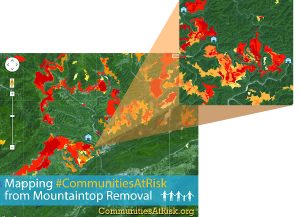Communities at Risk from Mountaintop Removal
Even as Appalachian coal production declines, mountaintop removal coal mining is encroaching on many communities in the region, according to an analysis and interactive mapping tool developed by Appalachian Voices, the publisher of The Appalachian Voice.
Appalachian Voices staff identified 50 regional communities that they deemed most at-risk based on proximity to mountaintop removal mining and the rate at which mining activity has been increasing. Krypton, Ky., Bishop, W.Va., and Roaring Fork, Va. were identified as the top three communities at risk, while the three counties that contain the highest number of at-risk communities are Pike County, Ky., Wise County, Va., and Boone County, W.Va.
Among the findings:
• Communities where mountaintop removal mine encroachment is increasing suffer higher rates of poverty and are losing population more than twice as fast as nearby rural communities with no mining in the immediate vicinity;
• Southwest Virginia had a disproportionate concentration of at-risk communities on the list (20 percent), but accounted for only eight percent of Central Appalachia’s surface mine coal production in 2014; and
• Communities that face the greatest threat are in areas where high-quality metallurgical coal is mined using mountaintop removal, particularly far southern West Virginia. Sixty percent of all central Appalachian surface mining occurred in 11 West Virginia counties in 2014, and the state contained nearly half of the 50 at-risk communities.
Much of the expanding surface mining is for metallurgical coal used to make steel, as opposed to thermal coal used in power plants. Metallurgical coal is usually exported overseas, says Appalachian Voices Program Director Matt Wasson, who developed the methodology for the web tool.
“The human suffering and environmental destruction from mountaintop removal mining won’t just disappear as America’s aging power plants retire,” he says. “It’s incumbent on the Obama administration to help revive this region that has powered the nation’s economic ascendancy for generations, starting with ending mountaintop removal mining.”
Major national news about the Appalachian coal mining region has focused on coal company bankruptcies, mine layoffs and steep declines in coal production since 2012 — the year that production from the Marcellus Shale made natural gas a more economically viable source of energy than Appalachian coal.
Prior to 2012, however, the dominant news story out of the region was the environmental and human impact of mountaintop removal coal mining and the Obama administration’s efforts to reduce the impact of the practice.
Mountaintop removal is a controversial form of large-scale surface coal mining that involves using explosives to blast the tops off of mountains to access thin seams of coal. Over the past six years, dozens of scientific papers have linked mountaintop removal to human and environmental impacts that range from increased rates of cancer and birth defects among people living near these mines, to high levels of pollutants in downstream water supplies and the disappearance of entire orders of aquatic organisms from mine-impacted streams.
Appalachian Voices developed the map and identified the 50 communities most at risk using Google Earth Engine, U.S. Geological Survey data, publicly available satellite imagery, mining permit databases and mapping data and consultation from Skytruth. The mapping tool was developed for iLoveMountains.org on behalf of The Alliance for Appalachia. Explore the map at CommunitiesAtRisk.org
Related Articles
Latest News

Leave a comment
Your email address will not be published. Required fields are marked *






Leave a Comment